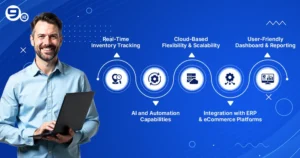Warehouse management no longer remains a place for storing products; it’s all about tracking inventory movement, spotting delays, order picking, packing, and shipping items. Investing in the right warehouse management software can transform your operations with built-in features of inventory tracking, barcode scanning, control access, shipment delivery, and query response.
Choosing the ideal warehouse management software in 2025 helps you avoid shipment delays and overstocking. As the eCommerce, manufacturing, wholesalers, and healthcare industries progress with new sales channels, smart stores, and automated warehouse operations, it is undeniable that the smartest choice is to ensure accuracy and order fulfillment. Overall, the global market for warehouse automation was valued at $23 billion in 2023, which will rise to $41 billion by 2027.
Here is a guide blog to help you search for the best warehouse management software, its benefits, and the steps to implement it.
Understanding Warehouse Management Software in 2025
Warehouse Management software is designed to optimise functions and inventory distribution. It creates a comprehensive system to track inventory levels, manage orders, packing, and shipping, and generate real-time data reporting. With advanced mechanisms of RFID (Radio Frequency Identification), barcode scanning, and data analytics, you can explore different warehouse management software in 2025 that align with your business logistics and supply chain system.
Top choices among vendors for warehouse management software include Zoho Inventory, Fishbowl, ShipHero, NetSuite WMS, Microsoft Dynamics 365, Oracle, SAP, and Blue Yonder, which come with their scalable and customised solutions.
What is Warehouse Management Software (WMS)?
In traditional times, inventory management was handled through manual inventory counts and spreadsheets. It draws certain drawbacks of human errors, delays, and a tedious job to update the record for inventory stock. To overcome these challenges, the creation of inventory management system became essential for businesses. Today, Warehouse Management Software acts as a comprehensive tool to handle the entire process of warehouse operations, tracking items, reducing errors, organising inventory, and improving order accuracy. With the help of WMS, businesses can monitor for stock levels, automate packaging and pick-up tasks, and deliver quickly.
Warehouse Management Software is creating accurate inventory estimates, and automation can regularly update on under- and overstocking to ensure resource utilisation. WMS also consists of space optimisation to support logistics without any damage to perishable items. These tools integrate with other specialised software like sales, shipping, and accounting to handle smooth workflows across different departments. WMS helps businesses with extracting accurate inventory data, lowering operational costs through automation, and improving security with better access control for transparency.
Why is WMS Crucial for Modern Supply Chains?
In the modern era of technology-driven industry, supply chain demands for visibility, speed, and precision to deliver the best experience for fluctuating demand, omnichannel distribution, and same-day shipping. This is where supply chain software development services play a crucial role. So, here are the reasons that show the importance of WMS for the supply chain:
- WMS can increase productivity through optimised workflows and labor.
- It can handle high-volume data and perform faster analysis without any errors.
- Improves inventory accuracy to eliminate expensive stock imbalance.
- It can transform faster operations and flexibility for omnichannel support.
- It maintains real-time visibility for stock levels with forecasting demand, and fulfilling orders.
- WMS can promptly respond to market fluctuations and disruptions.
Key Features to Look for in the Best Warehouse Management Software
Most brands aim to upgrade their warehouses that adapt to changing demands and overcome operational challenges. To remain competitive and ensure easy deliveries, looking for the right features in your warehouse management software will help to keep pace with industry standards.
Real-Time Inventory Tracking
Real-time tracking for inventory data provides accurate details through automated alerts for low stock levels and slow-moving inventories. Businesses are proactively managing supply chains using features of barcode scanning and RFID to quickly locate products, pick items, and minimise delays for processing delays. Specialised WMS has inbuilt dashboards to track reports, cycle counting, zone tracking, and stock reconciliation.
AI and Automation Capabilities
From capturing sales orders to final delivery, automation is redeveloping the system to explore different methodologies and process fulfillments. It redirects warehouse operations to adopt technologies for robotics and voice-directed pickups for order fulfillment. Automated order processes can generate accurate invoices within seconds, with tracking for millions of transactions at once. WMS with automation optimising existing workflows for quick commerce deliveries, B2C, and B2B.
Cloud-Based Flexibility & Scalability
A cloud-based WMS provides more accessibility and flexible operation across multi-warehouse setups and supports international logistics. Any company looking to expand into a new market or product lines is ideal for cloud WMS to handle real-time data sync, scalability, and automatic updates for increasing order volumes. Cloud platforms provide automatic software updates to access maximum features without any additional costs.
Integration with ERP and eCommerce Platforms
Modern WMS should be compatible with third-party integration for eCommerce, accounting, CRM (Customer Relationship Management), ERP, and others. It ensures faster and unified data flow across departments by reducing errors in data silos. Due to this interconnectivity, businesses can forecast inventory, ease the procurement process, and generate reports. Businesses are following omnichannel retail to maintain accurate stock visibility across all physical and online outlets.
User-Friendly Dashboard and Reporting
A comprehensive dashboard for inventory-related data provides a centralised overview of warehouse operations for faster decision-making. Customised dashboards can consistently track KPIs to measure order accuracy, inventory turnover, and productivity. Visual elements like performance graphs, charts, and heatmaps simplify complex data to make informed decisions.
Also Read
How to Build a Logistics Management System?
How to Choose the Right WMS for Your Business?
Wondering, with too many options available in the market, how to identify the best warehouse management software for your business needs. Here are the steps to follow for finding the best software with ease of use, integration capabilities, and scalability.
Define Your Business Requirements
Before you start the search for Warehouse Management Software, it is crucial to address your business needs and challenges relating to warehouse operations. Whether you aim to integrate for small-scale businesses or large enterprises, features and capabilities help you to limit choices for selecting the right WMS to meet your operational challenges.
Take a look…
How Much Does It Cost to Develop a Supply Chain Software?
Suppose for an eCommerce store, they are in search of core features like real-time stock updates and barcode scanning for avoiding overselling, while big retailers are in need of multi-warehouse tracking, advanced analytics, and ERP integrations.
Compare Pricing Models and ROI
Next, an important component is considering the WMS cost by comparing different pricing models. Whether you choose one-time upfront costs or a subscription model with recurring costs, it will directly affect the estimated Return on Investment (ROI).
Assessing these cost models, it evaluates WMS to improve productivity, features, integration, and flexible plans.
Startups and small-scale businesses with constrained budgets count on subscription models to ease payments, while established logistics companies opt for one-time investments, considering value for long-term benefits.
Check Vendor Support and Training
Advanced warehouse management software should be backed by effective training and support. So, businesses should assess that vendors provide guiding manuals, training videos, and 24/7 customer support for effective implementation. Most operators prefer the vendors or suppliers to provide frequent updates, continuous training, and multiple support channels.
Any mid-sized manufacturer chooses a WMS that can provide dedicated onboard sessions and round-the-clock support to assist employees with the new process.
Consider Customization and Future Upgrades
Every business has a unique warehouse operation style, and adapting a standalone WMS doesn’t fit the requirements. Market demand for software that is more customisable for workflows, dashboards, and integrated features. It brings more flexibility and supports modular add-ons for technologies like AI, ML, and IoT. So, the business should choose a scalable software that grows as the warehouse operation expands.
Also Read
How Much Does It Cost to Develop Logistics Software?
Fashion brands deal with dynamic change for seasonal demand to predict inventory needs that require constant upgrades and customisation. On the other side, automotive companies aim for future tech like IoT sensors to integrate with WMS for tracking inventory at multiple warehouses.
Benefits of Adopting WMS in 2025
Having the best warehouse management software aside can resolve business challenges and contribute beyond inventory controls to transform the entire operations. From automated data tracking to predictive analytics, these tools and software assist in better warehouse management.
Improved Accuracy and Reduced Errors
WMS can reduce manual errors and improve inventory accuracy through stock updates, RFID tracking, and barcode scanning to record real-time details. We can take the example of a retail store, where during peak seasons, there is a surge in demand, and multiple festive discount offers might be chaotic to track with a manual process. With the help of WMS, staff can take note of inventory discrepancies, incorrect shipments and reduce stockouts.
Enhanced Productivity with Automation
Automation improves the warehouse operation through better resource utilisation, optimised workflows, and repetitive tasks. It provides benefits for supply chain distribution with automated route pickups and demand forecasting to spend less on manual work. An eCommerce store like Amazon can process more than 1000 orders at once by integrating robotics and automated conveyors, which results in faster operations, lower labor costs, and quicker turnaround times.
Better Customer Satisfaction through Faster Fulfillment
In the modern era, the fastest 10-minute delivery has become the top trend and key move to achieve customer satisfaction. With the help of best warehouse management software, this process turned out to be faster and organised through order updates, speed packing, and pickups to deliver on time. Suppose a toy store where shelves are packed with millions of toys of different varieties and age groups. Integrating WMS helps guide an easy route and generate details about each shelf to save customer time for offline stores and fast delivery for online orders.
Steps to Avail the Best Warehouse Management Software in 2025
Navigating the market to avail the best warehouse management software can be challenging; however, a structured approach helps to find software that supports future operations. Here are the following steps to select the right alternative:
Research and Shortlist Vendors
Firstly, define your requirements for warehouse operations and determine the type of WMS to look for. Now, create a list of vendors to track the best one that fits your budget, business size, and features. Preparing a checklist beforehand will help to track vendors or suppliers that align with your business needs and scalability terms. Due to this pre-shortlisting criteria, it saves time and gives more assurance that the software is capable to meet for operational demands.
Request Free Trials or Demos
Now, software technicalities can’t be judged and observed; the business should request for demo and free trials to test for software features. One of the best approaches to convince your management and stakeholders of the usability of the software. Requesting hands-on trials and demos can generate accurate data to measure for KPIs, labor cost savings, and reduce errors.
Evaluate Case Studies and Reviews
Avoid depending solely on the vendor’s claims; you can check reviews and feedback from customers within the comparable industry for complete authentication. Certain companies require a targeted solution that confirms whether the software addresses warehouse issues, like inventory discrepancies, delayed orders, and ineffective workforce management. Companies can review comments on the vendor’s site, discussion boards, and independent platforms to obtain genuine feedback on the warehouse provider’s services.
Finalise Based on Scalability and Support
Investing in scalable WMS helps business growth to handle increased order volumes, managing remote warehouses, and integrating new sales channels. Ensuring that the software has the listed features of future tech, like automation and IoT integration. It extends the scope of usability and gives an overall estimate of comprehensive training and ongoing technical assistance. Also, verify that vendor support is available for 24 hours, multiple-channel compatibility, and security from network failures.
Why NineHertz is the Best Option to Avail a Custom Warehouse Management System in US
Looking for experts to avail the best custom warehouse management software development services in the US? NineHertz is your professional development partner to offer smart solutions with integrated features of real-time inventory tracking, space utilisation, and higher profit. Partnering with our experienced developers will guide you to the best technology stack and trending software solutions like robotics assistance, conveyor systems, smart sorting, and IoT sensors to track for structured planning. Connect with the top developers in the US who have an extended record of delivering over 1000+ projects and serving over 100+ industry sectors.
Conclusion
In the smart tech generation of 2025, lagging behind in your manual process of warehouse management would be a worse decision. Top brands like Zoho, SAP, Oracle, and NetSuite are developing their warehouse management software with custom features of demand forecasting, barcode scanning, real-time inventory tracking, and eCommerce migration. Businesses focus on availing the best warehouse management software depending on their business size, scale, warehouse complexities, and industry standards. So, whether you are looking for cloud-based WMS or ERP integration software, get a comparison for top features, functionalities, platform integration, and tracking performance to get the best in the market.
Frequently Asked Questions
What is Warehouse Management Software (WMS)?
Warehouse Management Software is a tool that helps companies to manage their warehouse operations, considering the throughout process of picking items, packaging, shipping, distribution, and analytics.
Why do businesses need a Warehouse Management System?
Businesses need a warehouse management system to structure their supply chain and logistics workflows, improve inventory visibility, and automate the tedious tasks of space optimisation, order picking, and adapt to fluctuating demands.
How long does it take to implement a Warehouse Management System?
The timeline might be varying differently depending on the type of WMS you choose. For cloud-based WMS, it requires 4 to 8 weeks, 3 to 6 months for on-premise WM,S and beyond 6 months for complex setups.
Can small businesses benefit from using a WMS?
Yes, small businesses can save their resources and costs to get the benefit of real-time tracking, scalability, ease of use, automation, and flexible integration with other systems.
How much does a WMS typically cost in the US in 2025?
For 2025, the WMS cost range in the US will range from $100 to $300 per user/month to an overall package of $2,00,000+, depending on the scale of software.
What benefits will a modern Warehouse Management System deliver in 2025?
Some key benefits of modern WMS include space optimisation, improved stock control, internal automation, faster order processing, team connectivity, and better customer-supplier relationships.
Great Together!






![How to Create an App like Careem? [Cost in 2025]](https://theninehertz.com/wp-content/uploads/2024/09/how-to-create-an-app-like-careem.webp)
![How to Create an AI-Powered Wellness App? [2025 Guide]](https://theninehertz.com/wp-content/uploads/2025/11/how-to-create-an-ai-powered-wellness-app.webp)





